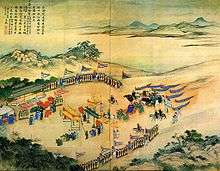Yeongeunmun
Coordinates: 37°34′20.14″N 126°57′35.46″E / 37.5722611°N 126.9598500°E
| Yeongeunmun | |
 | |
| Korean name | |
|---|---|
| Hangul | 영은문 |
| Hanja | 迎恩門 |
| Revised Romanization | Yeongeunmun |
| McCune–Reischauer | Yŏngŭnmun |
The Yeongeunmun (literally "welcoming gate for obligation") was a historical gate located in present Hyeonjeo-dong, Seodaemun-gu, in the northwestern part of Seoul, South Korea. It was built in front of Mohwagwan (hangul: 모화관, hanja: 慕華館) during the Joseon Dynasty where envoys dispatched from Ming and Qing China were received as diplomatic guests.
In 1896, the gate was demolished along with Mohwagwan one year after the First Sino-Japanese War ended, which was a war between China and Japan primarily for the control over Korea. The Korean independence activist Seo Jae-pil (known as Philip Jaisohn) built the Independence Gate on the site with the desire towards inspiring the spirit of independence in Korea.[1][2]
History

The Yeongeunmun Gate was located just outside the Donuimun (돈의문, 敦義門, West Gate) of the walled capital city of Hanseong (present-day Seoul). It was situated on the road from Seoul to Beijing, adjacent to the Mohwagwan. Its nearest post station was the Hongjewon (홍제원, 弘濟院).
Embassies were occasionally sent to Joseon by the emperor of the Ming Dynasty to announce imperial succession, investiture of a crown prince and others. When they reached the Hongjewon, they took off their traveling clothes and changed into formal attire. The next day, they received a reception from the king himself in front of the gate.[3] The rite was performed by the king two times in the history of Joseon. After Ming China envoys move off to the gate, King Jungjong performed a rite, in the direction of the Ming Dynasty emperor.[4] This ritual ceased in 1634.[5]
The Mohwagwan was first built in 1407 as "Mohwaru" (모화루, 慕華樓)[6] and then renovated in 1430.[7] It was located adjacent to the Mohwagwan, a gate with rosewood pillars was built on the road.
In 1537 the gate was rebuilt in accordance with Ming Dynasty customs. Being roofed with blue tiles and had "Yeongjomun" (literally gate of welcoming imperial decrees) written on the front tables.[8] In 1539 it was renamed to "Yeongeunmun" because the name of "Yeongjomun" was accused by the Ming Dynasty ambassador Xue Tingchong (薛廷寵). He claimed that since the imperial envoys carried imperial orders (勅), imperial decrees (詔), and imperial gifts, it was inappropriate to mention only imperial decree.[9] The tablet was written by Zhu Zhifan (朱之蕃), who came to Joseon as an ambassador in 1606.
As a result of the Treaty of Shimonoseki (1895) which ended First Sino-Japanese War, Qing China recognized the "full and complete independence and autonomy" of Joseon Korea. In the next year Yeongeunmun was demolished leaving only its two stone pillars. In front of the remnant, the Independence Gate was built by Philip Jaisohn.
Location
Seodaemun Independence Park, including the remnants of Yeongeunmun, is easily accessed from exits 4 or 5 of the Dongnimmun Station on Seoul Subway Line 3.
See also
Footnotes
- ↑ 영은문 (迎恩門) (in Korean). Empas / EncyKorea. Retrieved 2008-07-28.
- ↑ 모화관 (慕華館) (in Korean). Empas / EncyKorea. Retrieved 2008-07-28.
- ↑ To be precise, this routine was established during the Manchu Qing Dynasty. Before the Hongjewon was constructed, the nearest station was the Byeokjegwan in modern-day Goyang. Due to its great distance from the capital, the envoys of Ming arrival at the capital was often delayed until night. Fore more information, see Tongmungwan-ji 通文館志, Vol. 5, Sadae 事大, Gyoyeongui 郊迎儀.
- ↑ Jungjong Sillok 中宗實錄: the dingwei (10th) day of the 4th month, Jungjong 34
- ↑ Injo Sillok 仁祖實錄 仁祖 29卷, 12年(1634 甲戌 / 명 숭정(崇禎) 7年) 6月 14日(戊辰) 예조가 아뢰기를 "그러나 이것은 외국에서 응당 행하여야 할 예는 아닙니다." 하니, 왕이 이를 따랐다.(Korean)
- ↑ Taejong Sillok 太宗實錄: the guimao (22nd) day of the 8th month, Taejong 34
- ↑ Sejong Sillok 世宗實錄: the yiyou (15th) day of the 12th month, Sejong 12
- ↑ Jungjong Sillok 中宗實錄: the renwu (2nd) day of the 1st month, Jungjong 32
- ↑ Ŏ Sook-kwon 魚叔權: Folkloristic Notes (P'ae-kwan Chap-ki 稗官雜記), Im Dong-kwun et al. ed. Joseon Folklore Texts in Chinese Characters, pp. 98-99, Taipei, 1971.
References
- Keijō-fu 京城府: Keijō-fu shi 京城府史, Vol. 1, pp. 375–376, 1934.